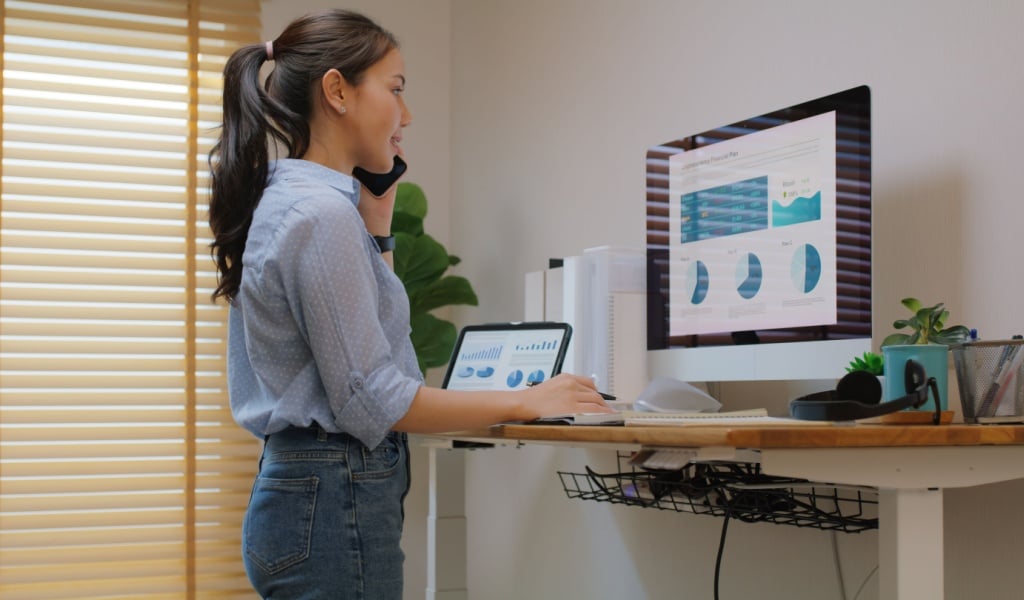Post-pandemic, working from home has become the new norm for most of us. And what’s not to love? You get to stay where you’re most comfortable; your commute includes walking from the bedroom to your workstation, increased family and downtime, and many more perks to this arrangement.

However, one of the most significant disadvantages of working from home is the lack of physical activity. It’s safe to say that the most exercise any of us used to get is the few minutes of walking involved in going to the office, but WFH eliminates the need for this. It also means you spend most of your day sitting in the same position!
The cumulative result of poor posture, repetitive actions, and decreased physical activity can manifest in back and neck pain. However, you don’t have to give up the convenience of WFH. In fact, you can leverage your position to incorporate practices that help you avoid body pain and enhance overall health. Let’s explore how:
Use an Ergonomic Chair
One of the perks of WFH is that you can work from your bed or couch—but you shouldn’t! At least, not all the time. The most important piece of equipment in your home office should be an ergonomic chair. Pick a chair with lumbar support and adjustable armrests. Your arms must be at a 90-degree angle while working to ensure optimal posture, and your back shouldn’t be too arched or leaning forward.
Ideally, your feet should be able to reach the ground and lay flat, with your hips and knees level (or the hips slightly above the knees), so make sure the chair is height adjustable. Consider placing something underneath for support if your feet do not reach the ground.
Adjust Your Screen
The computer or laptop screen should be at eye level to ensure no strain on your back, neck, or eyes. Your neck and shoulders must remain straight while your back is slightly arched for comfort. You do not want to have to lean forward or crouch down to look at the screen – this is a surefire path to Pain City!
If your device isn’t height adjustable, you can purchase commercially available stands for really affordable prices. You may also want to invest in a deck with a pullout keyboard drawer, as the perfect keyboard position is below the elbows.
Consider a Standing Desk
Ideally, you’d change your position every 30 minutes – but this isn’t a realistic ask for anyone focused on finishing their tasks for the workday. A compromise would be to swap your regular desk for a standing desk or give it an upgrade with a standing desk converter.
When shopping for standing desks, make sure to go over the details thoroughly before picking one. Not all of them are height adjustable, so make sure the desk you choose suits you. The recommendations for optimal posture, such as maintaining a 90-degree angle for the elbow and not having to crouch, still stand for this type of desk. You can also choose between manual or electric adjustable models and choose add-ons such as wheels or additional shelves.
Using your standing desk should also be done with consideration. Sedentary standing isn’t much better than passive sitting, so make sure to move or change positions frequently. Consider investing in a walking pad that goes under the desk so you can work and exercise simultaneously!
Take Every Chance to Move
It cannot be said enough—your body needs to move! Since WFH gives you little opportunity to do that, you need to make a conscious effort to stay physically active. This can be done through the use of a standing desk and walking pad or by taking any pockets of free time you get to move your body (dance to some music, do a few pushups, walk to the local grocery store, etc.).
Take regular “sitting” breaks, ideally 1-2 minutes every half an hour, but realistically, as often as possible. You can also incorporate an exercise or yoga routine into your day specifically designed to alleviate back and neck pain. It’s also important to avoid repetitive tasks, such as always using the same hand for specific tasks. Switch it up so your body stays agile!
Limit Phone Usage
Working from a computer is far more ergonomic than working from a smartphone. The smartphone is handheld, which means you’ll have to be bent over to use it, leading to a plethora of issues, such as shoulder, neck, or back pain.
Therefore, it’s best to stick to using the computer when typing long messages or attending work calls/meetings. You can also use a headset, headphones, or smartphone speaker if necessary. Whatever you do, always avoid the awkward balancing act of placing the phone between your ear and shoulder in the name of multitasking!

Other Factors That Affect Your Back and Neck
Eyesight
At first glance, your eyes may not seem like they should affect your neck or back, but increased straining and squinting can, in fact, do so. A simple solution would be to increase the size of text on your screen. You might also want to call your optometrist to schedule that eye exam you’ve been putting off!
Core
Your core muscles support your neck and back, so failing to engage them can lead to increased strain, especially if you’re prone to more extended periods of sitting or immobility. You can get professional help from a physical therapist or follow DIY tutorials online for exercises that work on the abs and glutes.
Feet
If you have invested in a standing desk, the next step is to get comfortable shoes with good support. Improper footwear can cause undue strain on your spine.
Sleep
A good night’s rest affects almost every aspect of your day, including the workday. Make sure you have a comfortable sleeping environment free of distractions and noises. Consider investing in an ergonomic pillow to make sure there isn’t added strain on your spine.
Stress
Stress is another seemingly unrelated factor that can lead to neck and back pain. Stress can affect your body in ways that are direct and indirect, so it’s essential to practice stress-relieving activities frequently. This includes mindfulness practices like visualizations or breathing techniques. Make sure to schedule pockets of time for relaxation in your day so you can give your brain a break.



